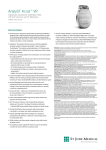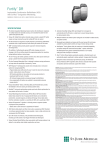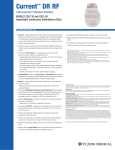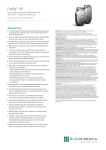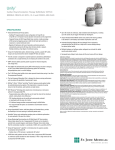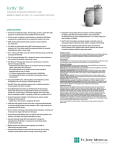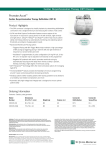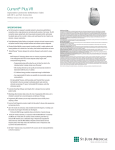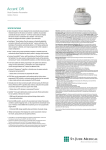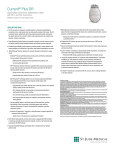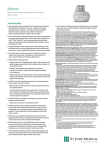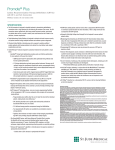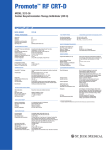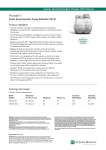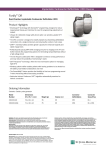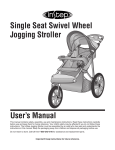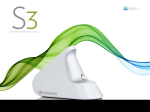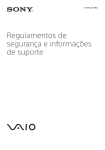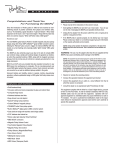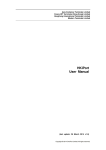Download AnalyST Accel™ DR
Transcript
AnalyST Accel™ DR Implantable Cardioverter Defibrillator (ICD) with SJ4 Connector and ST Monitoring MODEL CD2219-36q SPECIFICATIONS The SJ4 connector is designed to simplify implants by streamlining defibrillation connections into a single terminal pin and minimising the number of set screws. The SJ4 connection reduces pocket bulk, which may provide increased comfort, particularly for patients who are thin or small in stature, and could lessen the risk of lead-to-can abrasion, a known complication. The ST monitoring diagnostic in the AnalyST Accel™ ICD includes: – ST Histogram Data – graphical representation of ST deviations at different heart rate ranges to aid in determination of ST segment shifts. – ST Deviation Trending – total span of ST deviations over time. – ST Episode Log – log of episodes and associated electrograms that provide insight on significant ST segment shifts. AutoCapture™ Pacing System offers the maximum in threshold adaptability and patient safety with ventricular Beat-by Beat™ capture confirmation. The AutoCapture™ Pacing System automatically delivers a 5,0 V backup safety pulse when noncapture is detected, and it may be programmed to either a bipolar or unipolar configuration. ACap™ Confirm Pacing System periodically completes a threshold search and automatically adjusts amplitude to address patients’ changing atrial thresholds. Designed to reduce unnecessary right ventricular pacing, the VIP™ algorithm allows intrinsic conduction when possible and provides optimised ventricular support when needed. – Studies show an 81% decrease in unnecessary RV pacing.1 DeFT Response™ technology tools provide more clinically proven, non-invasive options for managing high DFTs. – Programmable pulse widths allow the user to tailor the shock to the individual patient, making shocks more efficacious.2 – SVC shocking electrode can be quickly and non-invasively activated or deactivated with the touch of a button. – 36 J delivered energy provides unsurpassed energy for defibrillation. – Four programmable tilt options are available to accommodate variances among patients.3 – Together, these features may help to prevent additional surgeries. Exclusive SenseAbility™ feature, with Decay Delay and Threshold Start, provides the flexibility to fine-tune sensing to individual patient needs and help eliminate oversensing of T waves, fractionated QRS complexes, and other extraneous signals. QuickOpt™ timing cycle optimisation provides quick and effective optimisation for more patients at the touch of a button.4 – IEGM-based AV optimisation allows optimised timing without need for echo-guided optimisation. Exclusive Morphology Discrimination plus AV Rate Branch SVT discrimination feature helps reduce the risk of inappropriate ICD shocks and is intended to promote fast, accurate diagnosis and delivery of therapy. Clinical data states that this combination resulted in a sensitivity of 100% with a specificity of 85%.5 Exclusive AF Suppression™ algorithm is clinically proven to suppress episodes of paroxysmal and persistent AF. – Studies show a 25% decrease in symptomatic AF burden.6 AT/AF Alerts notify patients and their clinics when a programmed AT/AF threshold or continuous episode duration has been exceeded, or when a high ventricular rate accompanies the AT/AF episode. Exclusive DC Fibber™ induction has a documented 95,5% success rate for inducing fibrillation on the first induction as compared with a 72,7% success rate for Shock-on-T.7 Exercise Trend Diagnostic provides insight into the patient’s disease state progression and exercise activity. Up to 45 minutes of continuous, fully annotated stored electrograms, including up to 60 seconds of pre-trigger information per electrogram. — Preferential EGM storage capability allows prioritisation of episode storage. Vibratory Patient Notifier allows even patients with hearing problems to be alerted to a low battery, lead-related complications and more. Automatic Daily High-Voltage (HV) Lead Integrity Test is designed to automatically test the HV lead on a daily basis to ensure therapy delivery for optimal patient safety. Multiple hardware and software system safeguards provide added security and patient comfort. The capability to program multiple ATP schemes per zone has the potential to increase the success of ATP prior to requiring a shock. InvisiLink™ Wireless Telemetry, in conjunction with the Merlin@home™ transmitter and Merlin.net™ Patient Care Network (PCN), allows for seamless remote monitoring and follow-up. InvisiLink™ RF telemetry uses a dedicated range of frequencies designated for medical devices called the MICS (Medical Implant Communications Service) frequency band, which helps reduce the interference seen on frequencies used by common household electronics. Indications: The devices are intended to provide ventricular antitachycardia pacing and ventricular defibrillation for automated treatment of life-threatening ventricular arrhythmias. Contraindications: Contraindications for use of the pulse generator system include ventricular tachyarrhythmias resulting from transient or correctable factors such as drug toxicity, electrolyte imbalance, or acute myocardial infarction. Warnings and Precautions: Implantation Procedure. The physician should be familiar with all components of the system and the material in this manual before beginning the procedure. Ensure that a separate standby external defibrillator is immediately available. Implant the pulse generator no deeper than 5 cm to ensure reliable data transmission. For patient comfort, do not implant the pulse generator within 1,25 cm of bone unless you cannot avoid it. Device Replacement. Replace the pulse generator within three months of reaching the 2,45 V indication. Replace the pulse generator immediately upon reaching 2,45 V if there is frequent high-voltage charging and/or one or more of the pacing outputs are programmed above 2,5 V. Battery Incineration. Do not incinerate pulse generators as they contain sealed chemical power cells and capacitors that may explode. Return explanted devices to St. Jude Medical. High-Voltage Can. Ensure that tachyarrhythmia therapy is programmed Off before handling the pulse generator to avoid any risk of accidental shock. Do not program tachyarrhythmia therapies On until the pulse generator is inserted in the pocket. For effective defibrillation, perform all defibrillation testing with the can in the pocket. Magnetic Resonance Imaging (MRI). Avoid MRI devices because of the magnitude of the magnetic fields and the strength of the radiofrequency (RF) fields they produce. Device Storage. Store the pulse generator at temperatures between 10° and 45°C. Do not subject it to temperatures below -20° or over 60°C. After cold storage, allow the device to reach room temperature before charging the capacitors, programming, or implanting the device because cold temperature may affect initial device function. Device Communication. Communication with the device can be affected by electrical interference and strong magnetic fields. If this is a problem, turn off nearby electrical equipment or move it away from the patient and the programmer. If the problem persists, contact St. Jude Medical. Lead Impedance. Do not implant the pulse generator if the acute defibrillation lead impedance is less than 20 ohms or the lead impedance of chronic leads is less than 15 ohms. Damage to the device may result if highvoltage therapy is delivered into an impedance less than 15 ohms. Suboptimal RF Communication. The Merlin™ PCS indicates the quality of the RF communication by the telemetry strength indicator LEDs on both the programmer and the Merlin Antenna. Disconnecting Leads. Connecting or disconnecting sense/pace leads can produce electrical artifacts that can be sensed by the pulse generator. To prevent detection of artifacts, reprogram the pulse generator to tachyarrhythmia therapy Off: Before disconnecting the leads from a pulse generator in the operating room; Before a post-mortem examination; Whenever there are no leads connected to it; When sense/pace leads are connected but are not implanted in a patient. If a programmer is not available, use a magnet to prevent delivery of tachyarrhythmia therapy in response to detected disconnection artifacts. Place the magnet over the pulse generator before disconnecting the leads. Do not remove it until the leads are reconnected. External Equipment for Arrhythmia Induction. If external equipment is used for arrhythmia induction through the pulse generator header and leads, apply rectified AC current through the high-voltage ports, not the sense/ pace ports, to avoid damaging the sense/pace function: disconnect the external equipment from the pulse generator before any therapy is delivered; otherwise, damage to the device is likely to occur. Place a magnet over the device until the external equipment can be disconnected. Adverse Events: Implantation of the pulse generator system, like that of any other device, involves risks, some possibly life-threatening. These include but are not limited to the following: acute hemorrhage/bleeding, air emboli, arrhythmia acceleration, cardiac or venous perforation, cardiogenic shock, cyst formation, erosion, exacerbation of heart failure, extrusion, fibrotic tissue growth, fluid accumulation, hematoma formation, histotoxic reactions, infection, keloid formation, myocardial irritability, nerve damage, pneumothorax, thromboemboli, venous occlusion. Other possible adverse effects include mortality due to: component failure, device-programmer communication failure, lead abrasion, lead dislodgment or poor lead placement, lead fracture, inability to defibrillate, inhibited therapy for a ventricular tachycardia, interruption of function due to electrical or magnetic interference, shunting of energy from defibrillation paddles, system failure due to ionising radiation. Other possible adverse effects include mortality due to inappropriate delivery of therapy caused by: multiple counting of cardiac events including T waves, P waves, or supplemental pacemaker stimuli. Among the psychological effects of device implantation are imagined pulsing, dependency, fear of inappropriate pulsing, and fear of losing pulse capability. Refer to the User’s Manual for detailed indications, contraindications, warnings, precautions and potential adverse events. Post-Therapy Pacing (Independently programmable from Bradycardia and ATP ) PHYSICAL SPECIFICATIONS Models Telemetry Delivered Energy Volume (cc) Weight (g) Size (mm) Defibrillation Lead Connections Sense/Pace Lead Connections High Voltage Can CD2219-36Q RF 36 J 41 80 74 x 50 x 14 SJ4 IS-1; SJ4 Electrically active titanium can Post-Shock Pacing Mode Post-Shock Base Rate (min-1) Post-Shock Pacing Duration (min) PARAMETERS Settings Patient Notifiers Device Testing/Induction Methods DC Fibber™ Pulse Duration (sec) Burst Fibber Cycle Length (ms) Noninvasive Programmed Stimulation (NIPS) AF Management AF Suppression™ Pacing No. of Overdrive Pacing Cycles Maximum AF Suppression Rate Programmable Notifiers (On, Off) Device Parameter Reset Entry into Backup VVI Mode Vibration Duration (sec) Number of Vibrations per Notification Number of Notifications Time Between Notifications (hours) On; Off 15-40 in increments of 5 80-150 min-1 Sensing/Detection SenseAbility™ Technology Threshold Start Decay Delay Ventricular Sense Refractory (ms) Detection Zones SVT Discriminators Reconfirmation Automatic Sensitivity Control adjustment for atrial and ventricular events (Post-Sensed, Atrial) 50; 62,5; 75; 100%; (Post-Paced, Atrial) 0,2-3,0 mV; (Post-Sensed, Ventricular) 50; 62,5; 75; 100%; (Post-Paced, Ventricular) Auto; 0,2-3,0 mV (Post-Sense/Post-Pace, Atrial/Ventricular) 0-220 125; 157 VT-1; VT-2; VF AV Rate Branch; Sudden Onset, Interval Stability; Morphology Discrimination (MD) with Manual or Automatic Template Update Continuous sensing during charging Stored Electrograms Therapy Summary Episodes Summary Lifetime Diagnostics AT/AF Burden Trend Ventricular HV Lead Impedance Trend Histograms PMT Data Real-Time Measurements (RTM) ST Monitoring Ramp; Burst; Scan; 1 or 2 schemes per zone Adaptive; Readaptive or Fixed 150-400 in increments of 5 1-15 2-20 On; Off 7,5 Independent from Bradycardia and Post-Therapy Pacing 1,0 or 1,5 Independently programmable from Bradycardia and Post-Therapy Pacing High-Voltage Therapy High-Voltage Output Mode Waveform RV Polarity Electrode Configuration Fixed Pulse Width; Fixed Tilt Biphasic; Monophasic Cathode (-), Anode (+) RV to Can; RV to SVC/Can Bradycardia Pacing Permanent Modes DDD(R); DDI(R); VVI(R); AAI(R); Pacer Off Temporary Modes Off; DDD; DDI; VVI; AAI; AAT; DOO; VOO; AOO Rate-Adaptive Sensor (Post-Sense/Post-Pace; Atrial/Ventricular) 0-220 Programmable Rate and Delay Parameters Off; Base Rate (min-1); Rest Rate (min-1); Maximum Tracking Rate (min-1); Maximum Sensor Rate (min-1); Paced AV Delay (ms); Sensed AV Delay (ms); Rate Responsive AV Delay; Pulse Amplitude (Atrial, RV) (V); Pulse Width (Atrial and RV) (ms); Hysteresis Rate (min-1); Rate Hysteresis with Search ™ QuickOpt Timing Cycle Optimisation Sensed/Paced AV delay Auto Mode Switch (AMS) Off; DDI(R); VVI(R) Atrial Tachycardia -1 Detection Rate (min ) 110-300 AMS Base Rate (min-1) 40; 45;...135 Auto PMT Detection/Termination A Pace on PMT; Off; Passive Rate Responsive PVARP/VREF Off; Low; Medium; High ™ Ventricular Intrinsic Preference (VIP ) Off; 50-200 (50-150 in increments of 25; 450 to 200 in increments of 10) ™ Ventricular AutoCapture Pacing System On; Off ACap™ Confirm On; Monitor; Off Atrial Fibrillation Cardiac Rhythm Management Cardiac Surgery Cardiology Global Headquarters One Lillehei Plaza St. Paul, Minnesota 55117 USA +1 651 483 2000 +1 651 490 4310 Fax Cardiac Rhythm Management Division 15900 Valley View Court Sylmar, California 91342 USA +1 818 362 6822 +1 818 364 5814 Fax St. Jude Medical Sweden AB Veddestavägen 19 175 84 Järfälla Sweden +46 8 474 40 00 +46 8 760 95 42 Fax St. Jude Medical Coordination Center BVBA The Corporate Village Da Vincilaan 11 Box F1 1935 Zaventem Belgium +32 2 774 68 11 +32 2 772 83 84 Fax St. Jude Medical Brasil Ltda. Rua Frei Caneca, 1380 7º ao 9º andares 01307-002 - São Paulo (SP) Brazil +55 11 5080 5400 +55 11 5080 5423 Fax St. Jude Medical (Hong Kong) Ltd. Unit 2701-07 27/F, COSCO Tower Grand Millennium Plaza 183 Queen’s Road Central, Hong Kong +852 2996 7688 +852 2956 0622 Fax 0,5-5,0 20-100 2-25 stimuli with up to three extrastimuli Device at ERI; Charge Time Limit Reached; Possible HV Circuit Damage; Atrial Lead Impedance Out of Range; Ventricular Lead Impedance Out of Range; High-Voltage Lead Impedance Out of Range; AT/AF Burden On On 2; 4; 6; 8; 10; 12; 14; 16 2 1-16 10; 22 Electrograms and Diagnostics Antitachycardia Pacing Therapy ATP Configurations Burst Cycle Length Min. Burst Cycle Length (ms) Number of Bursts Number of Stimuli Add Stimuli per Burst ATP Pulse Amplitude (V) ATP Pulse Width (ms) Off; AAI; VVI; DDI; or DDD 30-100 in increments of 5 Off; 0,5; 1; 2,5; 7,5; or 10 Up to 45 minutes including up to one minute programmable pre-trigger data per VT/VF diagnosis/detection electrograms; triggers include diagnosis; therapy; atrial episode; PMT termination; PC shock delivery; noise reversion; magnet reversion; and morphology template verification Diagram of therapies delivered Directory listing of up to 60 episodes with access to more details including stored electrograms History of bradycardia events and device-initiated charging Trend data and counts Multi-Vector Trend Data Event Histogram; AV Interval Histogram; Mode Switch Duration Histogram; Peak Filtered Rate Histogram; Atrial Heart Rate Histogram; Ventricular Heart Rate Histogram; AT/AF Burden; Exercise and Activity Trending; V Rates during AMS Information regarding PMT detections Pacing lead impedances; high voltage lead impedances; unloaded battery voltage; and signal amplitudes ST Histogram Data; ST Deviation Trend; ST Episode Log 1 Matthew T Bennett et al. The ICD alert is potentially an unreliable ICD warning feature. Canadian Cardiovascular Congress. 2 Mouchawar G, Kroll M, Val-Mejias JE et al. ICD waveform optimization: a randomized prospective, pair-sampled multicenter study. PACE 2000; 23 (Part II):1992-1995. 3 Sweeney MO, Natale A, Volosin KJ, et al. Prospective randomized comparison of 50%/50% versus 65%/65% tilt biphasic waveform on defibrillation in humans. PACE 2001; 24:60-65. 4 Baker, et al. Acute Evaluation of Programmer-Guided AV/PV and VV Delay Optimization Comparing an IEGM Method and Echocardiogram for Cardiac Resynchronization Therapy in Heart Failure Patients and Dual-Chamber ICD Implants. Journal of Cardiovascular Electrophysiology, Vol. 18 No. 2, Feb. 2007. 5 Sperzel J, Meine M et al. A new automatic update function of the morphology template used for SVT/VT discrimination in an ICD. Europace Supplements; Vol. 3, July 2002;A 131, #1515. 6 Carlson MD et al. A new pacemaker algorithm for the treatment of atrial fibrillation: results of the Atrial Dynamic Overdrive Pacing Trial (ADOPT). JACC 2003; 42:627-633. 7 Sharma AD, O’Neill PG, Fain E, et al. Shock on T versus DC for induction of ventricular fibrillation: a randomized prospective comparison. 21st Annual Scientific Session North American Society of Pacing and Electrophysiology (NASPE). Poster presentation published in meeting proceedings. Washington D.C., U.S.A. May 2000. Neuromodulation St. Jude Medical Japan Co., Ltd. 3-1-30, Minami-Aoyama Minato-ku Tokyo 107 0062 Japan +81 3 3423 6450 +81 3 3402 5586 Fax sjm.com Brief Summary: Prior to using these devices, please review the Instructions for Use for a complete listing of indications, contraindications, warnings, precautions, potential adverse events and directions for use. Devices depicted may not be available in all countries. Check with your St. Jude Medical representative for product availability in your country. Unless otherwise noted, ™ indicates that the name is a trademark of, or licensed to, St. Jude Medical or one of its subsidiaries. ST. JUDE MEDICAL, the nine-squares symbol and MORE CONTROL. LESS RISK. are trademarks and service marks of St. Jude Medical, Inc. and its related companies. ©2009 St. Jude Medical, Inc. All Rights Reserved. Item No. XXXXXXXXX


